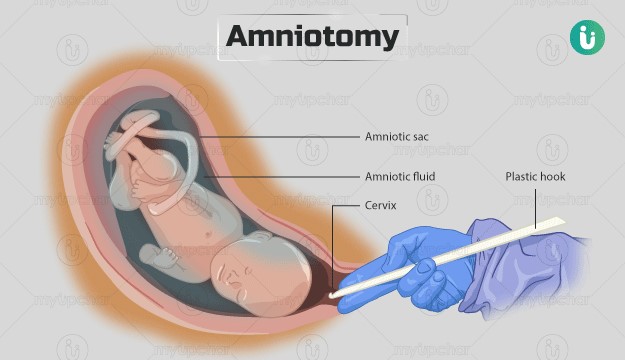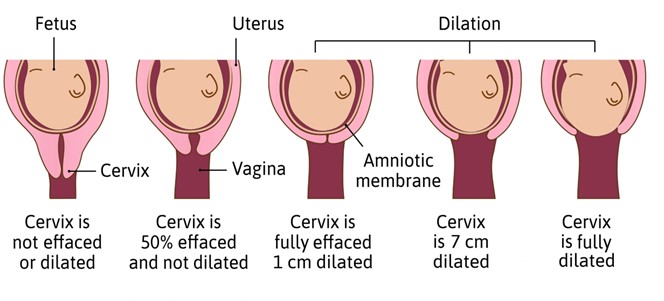A nurse is assisting in the care of a client following an amniotomy who is now in the active phase of the first stage of labor. Which of the following actions should the nurse take?
Check the client's temperature every 4 hr.
Remind the client to bear down with each contraction.
Maintain the client in the lithotomy position.
Encourage the client to empty the bladder every 2 hr.
The Correct Answer is D
Choice A reason: Check the client's temperature every 4 hr is incorrect, as this action is not frequent enough for a client who had an amniotomy. The nurse should check the client's temperature every 2 hr after an amniotomy, as there is an increased risk of infection due to the rupture of membranes. The nurse should also monitor for signs of chorioamnionitis, such as foul-smelling amniotic fluid, maternal tachycardia, or fetal tachycardia.
Choice B reason: Remind the client to bear down with each contraction is incorrect, as this action is not appropriate for a client who is in the active phase of the first stage of labor. The nurse should instruct the client to avoid bearing down or pushing until they are in the second stage of labor, when the cervix is fully dilated and effaced. Bearing down too early can cause cervical edema, lacerations, or exhaustion.
Choice C reason: Maintain the client in the lithotomy position is incorrect, as this action is not optimal for a client who is in the active phase of the first stage of labor. The lithotomy position is a supine position with the legs elevated and abducted, which can reduce blood flow to the uterus and placenta, increase perineal edema, and limit pelvic outlet diameter. The nurse should encourage the client to change positions frequently and use upright or lateral positions that can enhance uterine contractility, fetal descent, and maternal comfort.
Choice D reason: Encourage the client to empty the bladder every 2 hr is correct, as this action can promote labor progress and prevent bladder distension and infection. The nurse should assist the client to void every 2 hr after an amniotomy, as there may be decreased sensation of bladder fullness due to pressure from the fetal head. A full bladder can interfere with uterine contractions, fetal descent, and cervical dilation.

Nursing Test Bank
Naxlex Comprehensive Predictor Exams
Related Questions
Correct Answer is A
Explanation
Choice A reason: Fundal consistency is correct, as this finding can indicate the effectiveness of oxytocin in stimulating uterine contraction and preventing postpartum hemorrhage. Oxytocin is a uterotonic agent that can enhance or augment uterine contractility and involution. The nurse should monitor the fundal height, consistency, and position and report any signs of uterine atony or excessive bleeding.
Choice B reason: Fetal heart rate is incorrect, as this finding is not relevant for a client who has already delivered the baby. Fetal heart rate can indicate the fetal well-being and response to labor, but it is not affected by oxytocin administration after birth. The nurse should monitor the newborn's vital signs and appearance and report any signs of distress or infection.
Choice C reason: Pulse rate is incorrect, as this finding is not specific for evaluating the effectiveness of oxytocin. Pulse rate can indicate the client's hemodynamic status and response to blood loss, but it can be influenced by many other factors, such as pain, anxiety, fever, or dehydration. The nurse should monitor the client's vital signs and fluid balance and report any signs of shock or infection.
Choice D reason: Urinary output is incorrect, as this finding is not specific for evaluating the effectiveness of oxytocin. Urinary output can indicate the client's renal function and fluid balance, but it can be influenced by many other factors, such as fluid intake, bladder distension, or epidural anesthesia. The nurse should monitor the client's intake and output and report any signs of oliguria or retention.
Choice E reason: Blood pressure is incorrect, as this finding is not specific for evaluating the effectiveness of oxytocin. Blood pressure can indicate the client's hemodynamic status and response to blood loss, but it can be influenced by many other factors, such as pain, anxiety, preeclampsia, or medication. The nurse should monitor the client's vital signs and fluid balance and report any signs of hypotension or hypertension.
Correct Answer is D
Explanation
Choice A reason: Amniotic fluid in the vaginal vault indicates that the membranes have ruptured, but this does not necessarily mean that the client is in labor. Some women may have a slow leak of amniotic fluid for hours or days before labor begins. Rupture of membranes also increases the risk of infection, so the nurse should monitor the client's temperature and fetal heart rate.
Choice B reason: Contractions every 3 to 4 minutes are a sign of labor, but they are not enough to confirm it. The nurse should also assess the duration and intensity of the contractions, as well as the client's response to them. Some women may have false labor contractions, also known as Braxton Hicks contractions, which are irregular, mild, and do not cause cervical changes.
Choice C reason: Pain just above the navel is not a typical sign of labor. It may indicate other problems, such as placental abruption, uterine rupture, or fetal distress. The nurse should report this finding to the nurse midwife and check for other signs of bleeding, shock, or fetal compromise.
Choice D reason: Cervical dilation is the most reliable indicator of labor. It means that the cervix is opening and thinning out to allow the passage of the fetus. The nurse should measure the cervical dilation in centimeters and document it along with the station and effacement of the cervix.

Whether you are a student looking to ace your exams or a practicing nurse seeking to enhance your expertise , our nursing education contents will empower you with the confidence and competence to make a difference in the lives of patients and become a respected leader in the healthcare field.
Visit Naxlex, invest in your future and unlock endless possibilities with our unparalleled nursing education contents today
Report Wrong Answer on the Current Question
Do you disagree with the answer? If yes, what is your expected answer? Explain.
Kindly be descriptive with the issue you are facing.
